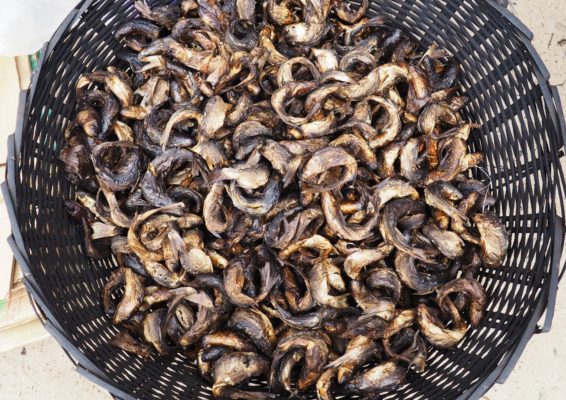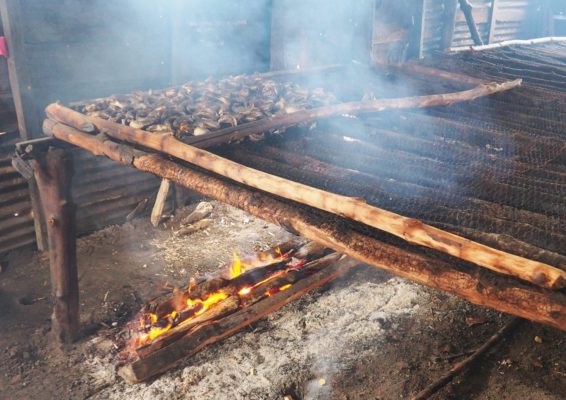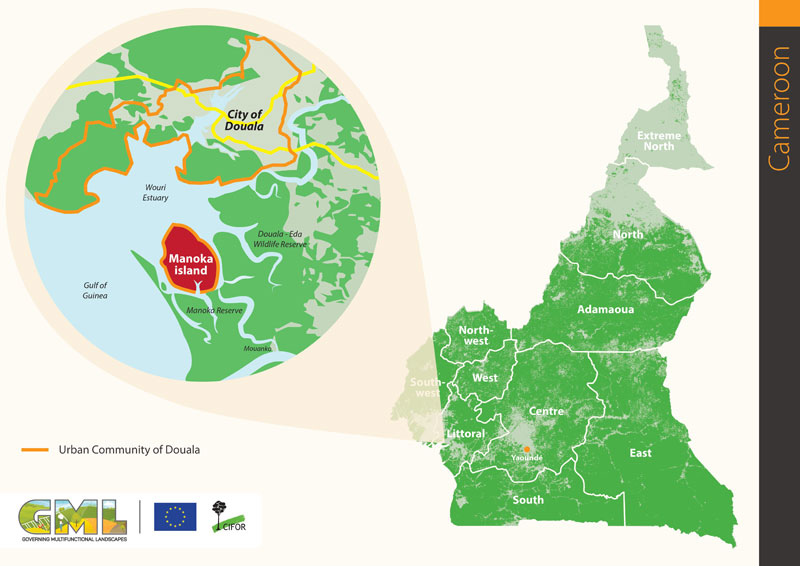Cameroon is home to some of Africa’s largest mangrove forests. The country’s unique shoreline ecosystems host important biodiversity, including mangroves and other tree species that can reach heights of up to 40 meters.
They also provide spawning areas for fish and crustaceans, and nooks and crannies where they can mature in safety. The rare Cameroonian ghost shrimp (Lepidophthalmus turneranus) after which the country is named — courtesy of Fernando Po, a 15th-century Portuguese explorer who was impressed by their sheer number — also finds safe haven in these waters: camarões means shrimp in Portuguese.
Studies show that about 30 percent of Cameroonians living in coastal areas depend on mangrove resources for their livelihoods, particularly fish, timber and non-timber forest products.
Mangrove forests are also one of Cameroon’s best weapons in the fight against climate change. They absorb carbon and regulate both the micro- and the macro-climate. Moreover, they stabilize the coastal areas and serve as a protective barrier against shoreline erosion.
However, despite their enormous value, Cameroon’s mangroves are threatened by population growth, rapid urbanization and economic development of the coastal zone. Government statistics estimate that the country loses about one percent of its mangroves every year. The mangrove forests of the Wouri estuary, close to the city of Douala, are the most vulnerable, destroyed at a rate of around 6.2 percent per year in the area of Douala-Bonaberi.
A sprawling city
Douala is a thriving urban area with a rapidly growing population of about 3.6 million. It is the economic capital of the country, and a major consumption center. The city’s demand for natural resources puts an enormous pressure on the peri-urban forests and the mangroves of the Wouri estuary.
Energy shortages remain one of the city’s main challenges. Electricity supply is unreliable or unaffordable for most families, who rely on wood fuel – in the form of charcoal or firewood – to meet their energy and cooking needs. Many of the city’s small businesses also use wood fuel for their economic activities, including bakeries, rotisseries, restaurants, distilleries and blacksmiths.
Moreover, fish is an important part of the diet of Douala’s inhabitants, and their main source of animal protein. But due to electricity outages fish conservation is challenging. Therefore, smoked fish, locally known as “mbounga,” has become an important ingredient in many typical Cameroonian dishes. The problem is that prevalent fish smoking techniques require huge amounts of mangrove wood.


Smoked fish island
Since 2018, the Center for International Forestry Research (CIFOR) has been working with the University of Douala and the non-governmental organization Cameroon Ecology on the Island of Manoka, and throughout the sixth district of Douala, to promote profitable and sustainable wood fuel value chains to protect the Wouri estuary’s mangroves.
Although unknown to most Cameroonians, Manoka is the biggest island in the country, and a major source of smoked fish to supply the city of Douala and beyond, including foreign countries. Most men on the island are fishers, while women are responsible for collecting wood and smoking fish. Manoka has about 2,000 inhabitants in total.

According to unpublished research by CIFOR, the island’s forest cover is about 56 percent of the territory. Between 1986 and 2018, close to 14 percent of its forest cover was lost. A study by Cameroon Ecology shows that 750 m3 of mangrove wood is used every year for smoking fish at the local level. These figures show that we must act quickly to avoid the irreversible degradation of this fragile ecosystem that plays such an important role in regulating the climate of the coastal zone.
The strategy of CIFOR and its partners is twofold: First, with financial support from the European Union, investments into the development of improved fish smoking technologies that could considerably reduce mangrove wood consumption and improve the working conditions for women are being put in place. Second, energy-saving solutions, such as improved stoves, are being promoted to reduce wood fuel consumption at the household level as well.
This is not a simple challenge. The proposed solutions can only be effective in the long term if local and affordable raw materials are used, if technologies are created that are appealing to users, and innovate with scalable business models. Our activities also need to be supported by awareness raising among wood fuel consumers to promote behavioral changes.
A call for action
On the occasion of the International Day for the Conservation of the Mangrove Ecosystem, we would like to stress that securing the future of Cameroon’s mangrove forests depends largely on our capacity to transform the country’s wood fuel sector.
The government at all levels needs to provide incentives for producers and users who are turning to sustainable alternatives. And we consumers need to become more concerned about the origin of the resources we use and their impact on the natural ecosystems.
This is the only way to ensure that future generations can also benefit from the many ecosystem services provided by mangrove forests.
We want you to share Forests News content, which is licensed under Creative Commons Attribution-NonCommercial-ShareAlike 4.0 International (CC BY-NC-SA 4.0). This means you are free to redistribute our material for non-commercial purposes. All we ask is that you give Forests News appropriate credit and link to the original Forests News content, indicate if changes were made, and distribute your contributions under the same Creative Commons license. You must notify Forests News if you repost, reprint or reuse our materials by contacting forestsnews@cifor-icraf.org.